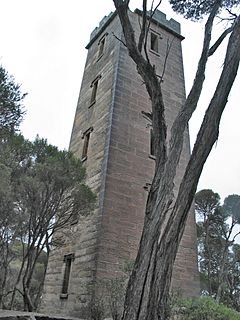Ben Boyd National Park facts for kids
Quick facts for kids Ben Boyd National ParkNew South Wales |
|
|---|---|
|
IUCN Category II (National Park)
|
|

Ben Boyd's tower
|
|
| Established | 1971 |
| Area | 104.86 km2 (40.5 sq mi) |
| Managing authorities | National Parks and Wildlife Service (New South Wales) |
| Website | Ben Boyd National Park |
| See also | Protected areas of New South Wales |
Ben Boyd National Park is a special natural area in New South Wales, Australia. It is about 578 kilometers (359 miles) south of Sydney. This park is a great place to explore nature and learn about history.
Contents
A Look Back: The Park's History
The park first opened in 1971. It covered about 8,900 hectares (22,000 acres) back then. The park was named after a rich businessman named Benjamin Boyd. Over time, the park grew to its current size of 10,486 hectares (25,910 acres).
About Benjamin Boyd
Benjamin Boyd was a wealthy person in the 1840s. He was involved in shipping and even whaling. He lived on the South Coast of NSW. Boyd was also elected to the NSW Legislative Council, which is like a government group.
However, Boyd was also known for something controversial. In 1847, he brought 65 workers from Melanesia to a place called Boyd Town. This was a practice of bringing people to work against their will, which was similar to forced labor.
Why the Name Change Talk?
Because of this history, there have been calls to change the park's name. These calls became stronger around 2020, during the Black Lives Matter movement. People felt that national parks should connect people, not divide them. The NSW Environment Minister, Matt Kean, said he would look into renaming the park. He promised to talk with local elders and the community about it.
Benjamin Boyd also started building a large sandstone tower. This tower was meant to help whalers spot whales from Twofold Bay. But the tower was never finished.
Exploring the Park: What's Inside?
Ben Boyd National Park has two main parts. These parts are on either side of Twofold Bay and the town of Eden.
Land and Rocks
The northern part of the park has mostly sedimentary rock. This means rocks like ironstone and clay that formed over a long time. You can also find some quartzite rocks there. A popular spot in this section is called the Pinnacles. It's a colorful gully where white sand sits under rusty red clay. It looks really unique!
The southern part of the park has older, metamorphic rocks. These rocks are from the Devonian period. You can see some amazing folded rock layers at a place called Red Point, near Boyd's tower.
The park is mostly flat. The northern part is less than 100 meters (328 feet) high. The southern part is a bit higher, with the tallest point being Haycock Hill at 252 meters (827 feet).
Plants and Trees
The park can be quite windy, dry, and cold. Because of this, the areas near the coast have low-growing plants called heathland. These plants hug the ground to survive the wind.
Further inland, you'll find open eucalypt woodland. This is where most of the park's trees grow. The two main types of trees are silvertop ash and red bloodwood. In some protected valleys, you can even find small areas of rainforest. Here, you might see trees like scentless rosewood and smooth mock-olive.
Amazing Animals
The park is home to many different animals. Over 212 types of birds have been seen here!
Birds of the Park
The heathlands are home to special birds like the eastern ground parrot and the endangered eastern bristlebird. The little tern builds its nests on the sand dunes and beaches. It's important to protect these nests from vehicles.
The park is also part of a larger area important for birds. This area helps protect swift parrots, which are also endangered.
Mammals and Other Wildlife
About 50 different types of mammals live in the park. You might see kangaroos or wallabies.
Sometimes, animals that don't belong in the park, like cats and foxes, can cause problems for the native wildlife. Rabbits can also be found in some areas. There's also a plant called Bitou bush that can grow too much and harm the natural plants.
Images for kids
See also
 In Spanish: Parque nacional Ben Boyd para niños
In Spanish: Parque nacional Ben Boyd para niños



